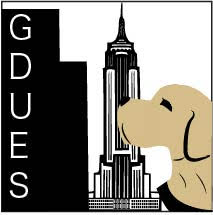FAQ Do you have questions about how a guide dog performs a task? We’ve got the answers.
Q: Can any dog be a guide dog?
A: No, not every dog has the ability to be a guide dog. It takes special qualities and a certain amount of independent thinking and attitude for a dog to develop the skills required for guide work. The most important skill is referred to as intelligent disobedience. This skill refers to the dog’s ability to refuse a handler’s command and not put the team in danger which requires a high level of critical thinking on the part of the dog.
Q: What breeds of dogs are the most popular?
A: The most popular breeds trained for guide work are the Labrador retriever, German Shepard dog and the golden retriever. Other breeds, like the Doberman, boxer, collie, and standard poodle are used. The health, temperament and trainability as well as size are all important factors in choosing a specific breed and many types of dogs can be used.
Q: Can a guide dog tell when it’s safe to cross the street?
A: Not exactly. While a guide dog can alert the handler to danger, like oncoming traffic, it is the handler’s job to judge when it is safe by listening to traffic and command the dog to proceed across a street or intersection. This is an example of how a guide dog team works together.
Q: Can I pet a guide dog?
A: No. When the harness is on and the dog is with the handler, it’s never okay to try to pet, talk to, or make cute noises to attract the dog. A dog could get distracted and lose focus, causing an injury to the handler and the dog. Remember the dog is working on keeping the team safe and this takes a high amount of concentration.
Q: Can guide dogs play and run like other dogs?
A: Yes, but only when off-duty and at the handler’s discretion.
Q: Do guide dogs bark?
A: Yes, but not when the harness is on and the dog is working. A calm and quiet disposition and the ability not to bark when excited are all hallmarks of a genuine service dog. Other hallmarks of a genuine service dog include excellent table manners and resting and lying quietly on the handler’s command, not relieving while in public, and ignoring /not showing any aggression when coming in contact with other dogs, children and other pets.
Q: Why can’t I give a guide dog a treat?
A: It is never okay to feed a working dog. The dog is trained to receive food rewards only from the handler and only for specific reasons. This strict control helps reinforce the dog’s training.
Q: How do I help someone with a guide dog?
A: The first step is to ask if the person requires assistance. If the person says yes, stay on the person’s right and ask if the person wants you to guide them or if you can walk ahead and have the dog follow you. Do not call the dog or give the dog directions. Give directions to the person, not the dog. Never assume the person wants to take your arm. Sometimes a handler will ask you to stay behind and to the right and give directions. The dog is used to this configuration and may respond better. Never try to take the dog’s leash or hold the harness handle or push or tug at the handler or dog.
Q: Are there places a guide dog can’t go?
A: Yes, a Private home owner has the right to not allow an animal in their home. Also a facility, such as a house of worship that does not receive any funding from government agencies, such as a church or synagogue, can say no to a service dog. Sterile environments, such as hospital surgical rooms can also reserve the right to deny a service dog. However, a service dog can accompany its handler during routine examinations and other non-surgical procedures. Additionally, service dogs cannot be denied transport during emergencies and first responders are obligated to assist in transporting the dog if the handler is injured or otherwise incapacitated.
Q: When a blind person corrects a guide dog, does it hurt the dog?
A: No, guide dogs respond to many types of corrections, some administered by a leash correction, which does not hurt the dog. Other corrections are given verbally or with a manipulation of the harness handle. When done appropriately, the corrections are like a tap on the shoulder or tug of the hand and does not cause any pain or duress for the dog.
Didn’t get the answer? Email info@gdues.org we’ll do our best to answer your question.
